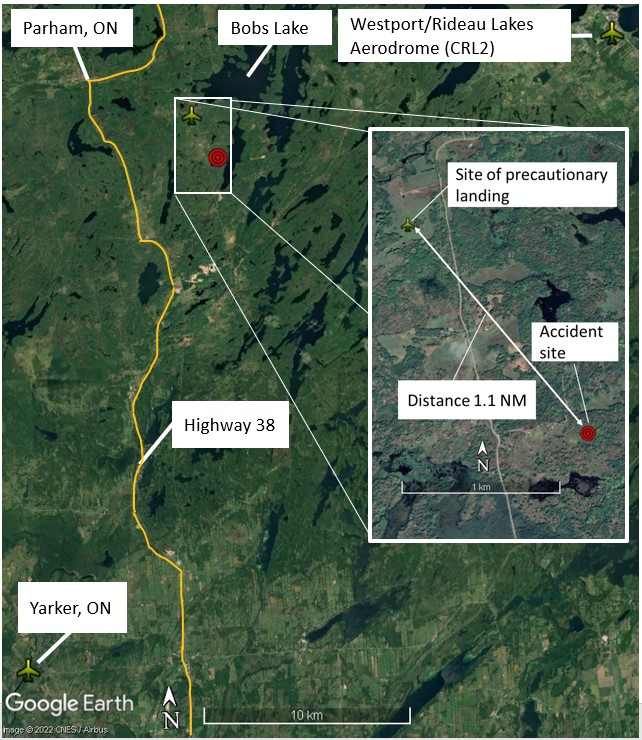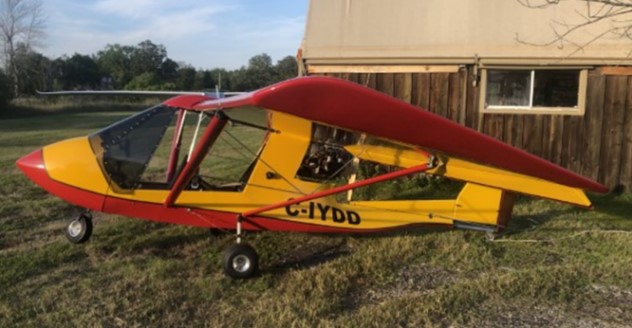Collision with terrain
Privately registered
Quad City Ultralight Aircraft Corporation
Challenger II (advanced ultralight), C-IYDD
Westport/Rideau Lakes Aerodrome, Ontario, 11 NM WSW
The Transportation Safety Board of Canada (TSB) investigated this occurrence for the purpose of advancing transportation safety. It is not the function of the Board to assign fault or determine civil or criminal liability. This report is not created for use in the context of legal, disciplinary or other proceedings. See Ownership and use of content. Masculine pronouns and position titles may be used to signify all genders to comply with the Canadian Transportation Accident Investigation and Safety Board Act (S.C. 1989, c. 3).
History of the flight
At 1248Footnote 1 on 24 September 2022, the privately registered Quad City Ultralight Aircraft Corporation (Quad City) Challenger II advanced ultralight aircraft (registration C-IYDD, serial number CH2-0604-2481) departed from a private grass runway near Yarker, Ontario, for a daytime visual flight rules (VFR) flight to Westport/Rideau Lakes Aerodrome (CRL2), Ontario. The pilot was the sole occupant on board. While the aircraft was en route, a door opened, and the pilot conducted a precautionary landing in a farmer’s field near Bobs Lake, east of Parham, Ontario. After landing, the pilot called the aircraft owner, who was waiting at CRL2, and requested that he come to the field to assist with the repair of the door.
After the repairs, at 1513, the aircraft departed from the field to resume the flight to CRL2. At 1515, shortly after takeoff, the aircraft was observed flying at a low altitude in a southerly direction. The engine was heard producing a sputtering sound and then stopping. The aircraft was then observed descending rapidly and rolling inverted before colliding with terrain in a wooded area. The pilot was fatally injured. There was no post-impact fire, but the aircraft was destroyed by impact forces. There was no emergency locator transmitter on board, and none was required by regulation.
Local residents called 911—a first call was made at 1516, followed by a second at 1521—and the residents subsequently initiated a search for the aircraft. At 1525, the Joint Rescue Coordination Centre in Trenton, Ontario, was notified of the accident and initiated a search and rescue (SAR) operation in the area (Figure 1). At 1635, a CH146 Griffon helicopter located the aircraft, and 2 SAR technicians were hoisted down to the accident site. Shortly afterwards, local firefighters arrived and assisted with the recovery of the pilot.
Pilot information
The occurrence pilot held a pilot permit – ultra-light aeroplane, which he had obtained in January 2008, and an instructor rating, which he had obtained in June 2011. His last examination for his Category 3 medical certificate had been completed on 16 May 2017; the certificate had expired on 01 June 2022.Footnote 2 He had accumulated approximately 530 total flight hours on ultralights. The investigation found no indication that the pilot's performance was degraded by fatigue or other physiological issues.
Weather information
The weather was suitable for the flight under VFR and was not considered a factor in this occurrence.
Aircraft information
The Challenger II is sold exclusively as a quick-build kit with several options, including engine upgrades, long or clip wings, and single- or 2-seat cockpits. The aircraft can be equipped with wheels, skis, or amphibious floats. In October 2022, there were 523 Challenger IIs on the Transport Canada (TC) registry.
The occurrence aircraft was purchased partly built from the original owner in 2016. The second owner completed the build and registered the aircraft as an advanced ultralight in 2017. In May 2020, it was sold to a third owner and flown to his aerodrome, where it remained in storage until the occurrence flight. In August 2022, the aircraft was sold to the owner at the time of the occurrence. The aircraft journey log indicated that the aircraft had accumulated 80.8 hours before the occurrence flight.
ROTAX engine
The ROTAX 503 UL is a 50 hp, 2-cylinder, in-line, 2-stroke aircraft engine. The engine manufacturer provides the following warnings:
Warning: This is not a certificated aircraft engine. It has not received any safety or durability testing, and conforms to no aircraft standards. It is for use in experimental, uncertificated aircraft and vehicles only in which an engine failure will not compromise safety.
[…]
Warning: Never fly the aircraft equipped with this engine at locations, airspeeds, altitudes, or other circumstances from which a successful no-power landing cannot be made, after sudden engine stoppage.Footnote 3
At the time of the accident, the aircraft was being operated at a low altitude and over a forested area, with limited suitable landing sites.
Previous occurrences
A search of data from 01 October 2012 to 13 October 2022 in the TSB Aviation Safety Information System identified 45 reported incidents and accidents involving the Challenger II aircraft. Of these, 23 occurrences involved an engine malfunction, power loss, or failure, 5 occurrences involved an aerodynamic stall, and 7 occurrences resulted in fatalities.
Aerodynamic stall and incipient spin
An aerodynamic stall is a loss of lift and an increase in drag that occurs when an aircraft is flying at an angle of attack greater than the angle that provides maximum lift. Regardless of airspeed, an aircraft always stalls when its wings reach this critical angle of attack.Footnote 4 Stall speed varies depending on factors such as the aircraft’s weight, power setting, flap position, and angle of bank. The occurrence aircraft’s records indicate that the stall speed was 28 mph in straight and level flight.Footnote 5
An incipient spin occurs when an aircraft stalls and one wing produces more lift than the other. Because the descending wing is at a greater angle of attack, it stalls even further and produces more drag, which triggers an autorotation. During this phase of the incipient spin, the flight path changes from horizontal to vertical.Footnote 6 Generally, even if the pilot takes the necessary measures to stop the autorotation as soon as it begins, the aircraft is in a vertical position while accelerating rapidly, and a high altitude is necessary to regain a horizontal flight path.
Impact and wreckage information
The aircraft was found in a steep nose-down, vertical attitude, leaning back against a tree. The fuselage sustained substantial impact damage and the left wing was crushed, but the right wing and empennage had only minor damage. The wooden propeller was found attached to the engine with no impact marks on the leading edge and no rotation marks. One of the blade tips had broken off from impact but was found at the accident site. There was a strong smell of fuel, some of which was found inside the fuel tank.
The aircraft systems were examined to the degree possible on site, and no indication of a malfunction was identified. The engine was recovered and taken to the TSB regional wreckage examination facility in Richmond Hill, Ontario. An examination of the engine, ignition, and fuel system did not reveal any indications of mechanical failure.
The aircraft was not equipped with a lightweight data recorder, nor was one required by regulation. Given the absence of data, the investigation could not determine the complete sequence of events that led to the loss of control and collision with terrain.
This report concludes the Transportation Safety Board of Canada’s investigation into this occurrence. The Board authorized the release of this report on . It was officially released on .

